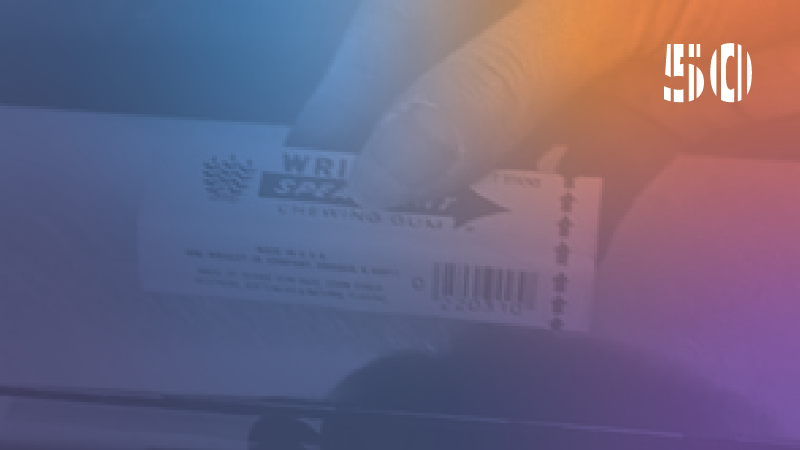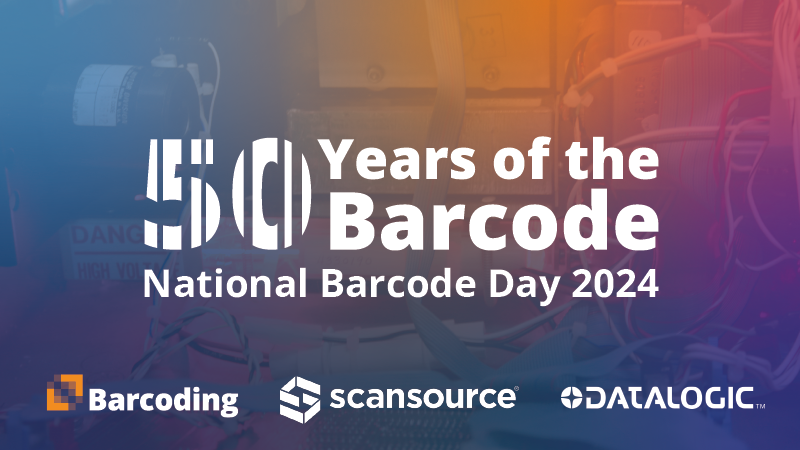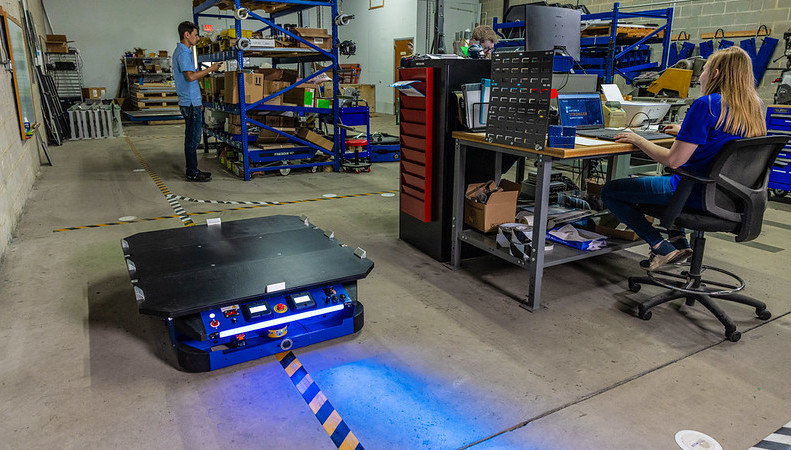With an increasing emphasis on cost reduction, global enterprises are looking for ways to improve efficiency and accuracy in their supply and distribution chains. To remain competitive, distribution centers, manufacturers, and short-haul and long-haul carriers must change the way they label and track goods. Success depends on maximizing efficiency throughout all supply chain operations—front to back. Exploiting mobile labeling technology is fundamental to achieving optimal efficiency.
The most effective way to improve efficiency and keep labor costs under control is to minimize the amount of time required to label materials, work in process, finished products, boxes and pallets. Centralized labeling solutions significantly reduce productivity and inject inaccuracies; thus, even the slightest improvement to the handling process will yield significant cost savings.
Barcode and RFID labels are by far the fastest and most accurate method to identify and track materials and products throughout the supply chain and within warehouses and distribution centers. Used in multiple industries, centralized printing stations affix barcodes and RFID labels to the materials, finished goods and packages.
When integrated with enterprise resource planning (ERP) software, these systems are a proven solution for significantly boosting operational efficiencies and reducing costs. However, tightening the supply chain even further calls for mobile printing solutions that equip workers with seamless mobility throughout the warehouse—wherever and whenever they need it.
“By using mobile wireless printers at the receiving dock to issue goods receipts, Driscoll Strawberry Associates reduced the time to process receiving transactions by 25 percent.”
Key Benefits of Mobile Printing Applications
IMPROVE WAREHOUSE OPERATIONS
Warehouse operations are often labor-intensive and filled with inefficiencies. In fact, printing at the point of use with mobile printers saves time and improves labeling accuracy in many common warehouse processes, including receiving, quality assurance, putaway, picking, packaging and shipping.
Receiving
A common practice for warehouse operations is to print batches of labels for incoming goods at a central IT office after receiving an advance ship notice (ASN) from a supplier. The labels are stored in the office and retrieved by a receiving worker when the shipment arrives. This process requires receiving dock staff to undergo time-consuming round trips between the dock and the office and creates the possibility of incorrect label attachment to the shipment.
Mobile label printers enable productivity gains and accuracy improvements by eliminating this manual, round-trip process. For example, workers can use forklift-mounted mobile printers to apply barcode or RFID labels on incoming materials immediately as they are unloaded from the receiving dock. This procedure ensures items are prepared for scanning and other automated processing systems within the facility.
Labeling items at the receiving area also ensures that incoming materials receive labels so that check-in, putaway, conveyor and other automated applications provide maximum benefits. Because mobile printers can work in a variety of environments, large freight warehouses can receive and label large, bulky items and cargo containers in the receiving yard, port dock or other outdoor locations. As a result, warehouse operations benefit from fewer trips between cargo and stations—saving time and operational costs.
Quality Assurance
Ensuring packages contain the right materials is a key aspect of warehouse operations. Mobile printers enable inspectors to create clear, legible labels that identify samples taken for quality assurance. Workers can tag items pulled from incoming shipments or from inventory with a tracking label to route the sample through testing and to serve as a work order indicating the required tests. Quality assurance workers can also use mobile printers to identify samples with “pass,” “rework” or “reject” labels. Mobile label printers can help reduce the risk of misidentified items—boosting quality assurance and compliance initiatives.
Putaway
Warehouse putaway tasks often suffer from delays due to time spent at the centralized printer and routing turnaround. A recent Zebra study determined that using mobile printers during putaway operations improved processing time by 62 percent. These efficiencies become reality when mobile printers work within an integrated system environment that includes mobile computers, wireless networks and shared databases.
An integrated system allows workers to initiate label requests by entering information into a handheld computer. The handheld transmits data to the company’s ERP system over a wireless LAN that covers the facility. The ERP system receives the transmission, updates inventory records and returns the information required to produce the barcode or RFID label.
Wireless-directed putaway operations also benefit from mobile printers. By receiving realtime updates of forklift locations and transaction activity, warehouse management system (WMS) software can balance workloads, calculate the most efficient route for each forklift driver, and communicate instructions in real time to a mobile computer on the vehicle. Then, forklift drivers can use their mobile printers to affix barcodes or RFID labels to the goods—saving as much as 30 minutes daily per worker.
Picking
Picking operations also benefit from wireless-enabled mobile printers because they enable operators to pick multiple orders simultaneously within a small zone—reducing empty travel time and raising productivity. Mobile printers are used to generate barcode or RFID labels for each item, which can then be scanned in the staging or packaging areas to expedite the sorting of items for specific shipments.
For example, a Midwestern distribution center implemented a wireless LAN to communicate picking instructions directly to its forklift drivers. The new process eliminated the travel time required to receive their pick lists from the office. Instead, drivers pick orders per the instructions received on their wireless computer and scan each item’s barcode label and shelf location label after picking the item. The handheld transmits the scanned data to the ERP server, confirming the item. The host application then formats a barcoded shipping label and sends the print job to a mobile printer mounted on the forklift. As a result, the distribution center realized a 50 percent reduction in picking time and a 100 percent increase in accuracy.
Finished Goods Packaging and Shipping
Printing at the point of use helps improve efficiencies during kitting or light assembly tasks or when workers place items into packaging. When assembly or packaging is complete, the worker can use the mobile printer to generate a label to identify the finished goods. In a similar application, warehouses and distribution centers can also use mobile printers to manage ship-to-order operations. Rather than identifying and labeling final assemblies, workers can use labeling and scanning to verify the picking and packing of all the items required to complete the order.
In the ship-to-order application, workers can label items with an order code during picking or packing to associate them with specific customers. When the final order finishes, the worker then uses a mobile printer to generate the shipping label. Doing so ensures the packing of the correct items into an order, and the proper shipping label identifies the order.
The Solution
ZEBRA® MOBILE PRINTERS
Efficient mobile printing requires a solution that delivers wireless-enabled communications, unmatched usability and versatile label encoding options. Zebra offers a complete range of mobile handheld and forklift-mountable wireless printers that meet diverse environmental and application needs for both barcode and RFID labeling.
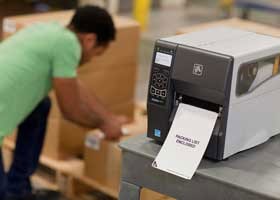 Zebra mobile printers extend the functionality of centralized thermal transfer printers, enabling workers to print labels wherever and whenever they need them. Printing labels on the spot, on demand, improves worker productivity by eliminating the travel and dwell time to and from a centralized printer. Operations also benefit from improved accuracy and quality control by ensuring the right label is applied to the right item.
Zebra mobile printers extend the functionality of centralized thermal transfer printers, enabling workers to print labels wherever and whenever they need them. Printing labels on the spot, on demand, improves worker productivity by eliminating the travel and dwell time to and from a centralized printer. Operations also benefit from improved accuracy and quality control by ensuring the right label is applied to the right item.
Embedded with common language support, Zebra mobile printers can create barcode or RFID labels using the same commands as with other Zebra tabletop or desktop printers.
Workers can print complex labels, symbologies and graphics quickly and easily. Zebra mobile printers enable several wireless connectivity options including 802.11, Bluetooth®, and dual radio support for using Bluetooth and WLAN on the same printer.
Save Time. Save Money. Now!
Printing at the point of use with mobile printers offers solutions that make warehouse-labeling operations more convenient, productive and cost effective. Supplementing enterprise printing operations with mobile printers eliminates bottlenecks and boosts accuracy, resulting in better overall performance of manufacturing, warehouse management and supply chain operations. Zebra mobile printing solutions are ready today to help streamline logistics and supply chain management—from the source to the destination.
A global leader respected for innovation and reliability, Zebra offers technologies that illuminate organizations’ operational events involving their assets, people and transactions, allowing them to see opportunities to create new value. We call it the Visible Value Chain.
Zebra’s extensive portfolio of marking and printing technologies, including barcode, RFID, GPS and sensoring, turns the physical into the digital to give operational events a virtual voice. This enables organizations to know in real-time the location, condition, timing and accuracy of the events occurring throughout their value chain. Once the events are seen, organizations can create new value from what is already there.
For more information about Zebra‘s solutions visit www.zebra.com.


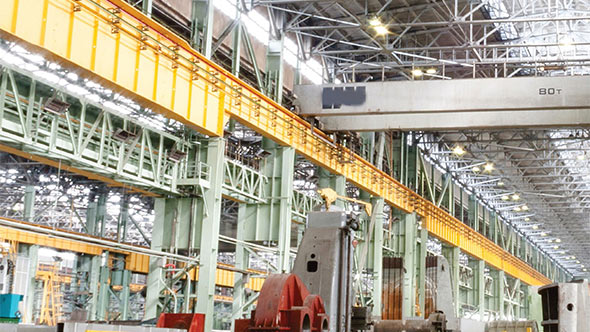
 Zebra mobile printers extend the functionality of centralized thermal transfer printers, enabling workers to print labels wherever and whenever they need them. Printing labels on the spot, on demand, improves worker productivity by eliminating the travel and dwell time to and from a centralized printer. Operations also benefit from improved accuracy and quality control by ensuring the right label is applied to the right item.
Zebra mobile printers extend the functionality of centralized thermal transfer printers, enabling workers to print labels wherever and whenever they need them. Printing labels on the spot, on demand, improves worker productivity by eliminating the travel and dwell time to and from a centralized printer. Operations also benefit from improved accuracy and quality control by ensuring the right label is applied to the right item.

